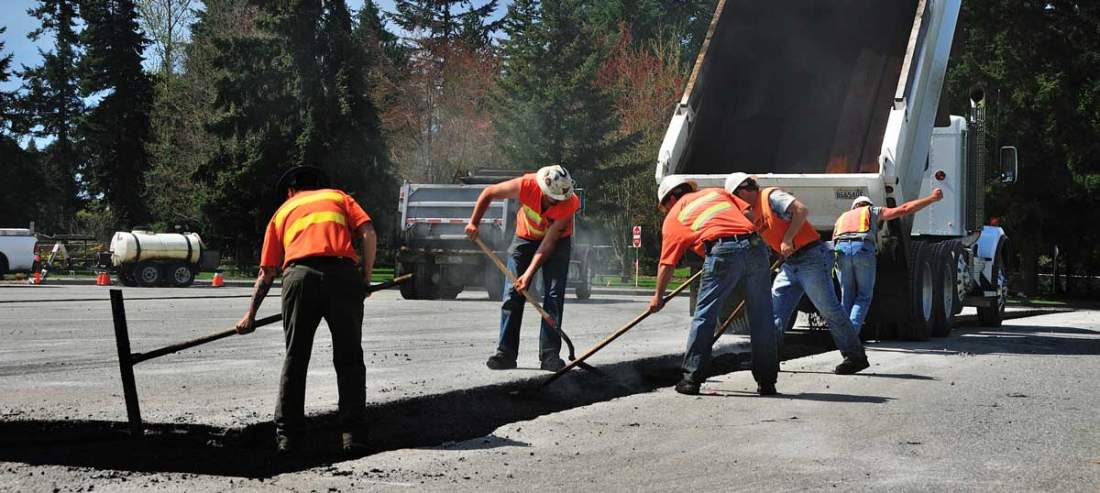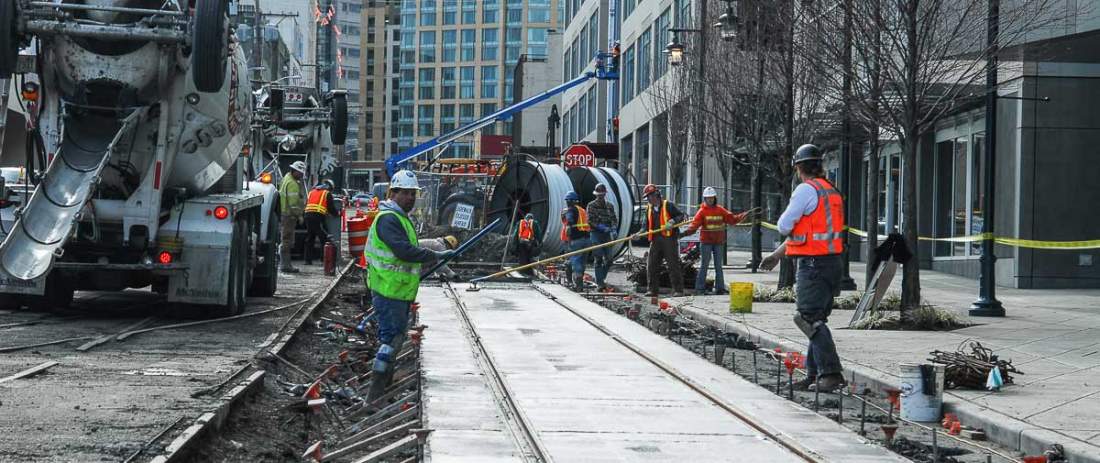
NWLETT’s Equal Opportunity Pledge
Northwest Laborers-Employers Training (NWLETT) will not discriminate against apprenticeship applicants or apprentices based on RACE, COLOR, RELIGION, NATIONAL ORIGIN, SEX (INCLUDING PREGNANCY AND GENDER IDENTITY), SEXUAL ORIENTATION, GENETIC INFORMATION, OR BECAUSE THEY ARE AN INDIVIDUAL WITH A DISABILITY OR A PERSON 40 YEARS OLD OR OLDER.
NWLETT will take affirmative action to provide equal opportunity in apprenticeship and will operate the apprenticeship program as required under Title 29 of the Code of Federal Regulations, part 30.
If you think you have been subjected to discrimination, you may file a complaint within 300 days from the date of the alleged discrimination or failure to follow the equal opportunity standards with Human Resources or the Training Director at 360.297.3035.
COVID-19 testing to begin at Kingston training site on 2/6/2022
Effective 2/6/2022, the Northwest Laborers-Employers Training Trust located in Kingston, Washington will require a negative COVID-19 test for anyone who wishes to stay onsite in the dorms during their scheduled training.
We have temporarily updated the arrival times due to the additional tine needed for testing. The testing will be administered at the Kingston site by a third party testing company.
TESTING IS ONLY REQUIRED IF YOU PLAN TO STAY ONSITE DURING YOUR TRAINING.
- COVID-19 testing is NOT required for those who are commuting to class daily. L
- If staying, you will need to fill out the provided consent form and give to the testing company.
- Picture ID is required.
- If you are scheduled for a class, you will be receiving a waiver with your class letter. In order to keep things flowing smoothly and efficiently as possible, please fill this form out beforehand and bring it with you to the testing area.
SUNDAY TESTING TIME: 4:00 p.m. to 8:00 p.m.
MONDAY TESTING TIME: 6:00 a.m. to 7:30 a.m.
What to do once you arrive onsite:
- Enter the main lobby of the dorm building.
- Give the testing company your COVID consent.
- Complete the testing and wait for your results.
- Dinner will be served from 5:00-5:30 p.m. on Sunday. You can arrive to eat dinner, but will not be permitted to register for class or be issued a dorm room until your COVID testing is complete.
NEGATIVE TEST RESULT: Yay! You can stay.
- Go to the front office to fill out the class registration paperwork.
- Your dorm room will then be assigned.
POSITIVE TEST RESULT:
- Leave the training site and follow the CDC’s COVID protocol guidelines.
- Apprentices will need to contact their coordinator.
If you wish to decline the COVID-19 test, you can still attend class but will not be allows to stay onsite in the dorms. If you decide to stay offsite at a hotel, the accommodation cost is your responsibility.
Our goal is to do our very best to offer a safe environment while honoring our mission; thank you for your cooperation.
Coronavirus: Operations Update
Coronavirus update
Due to the present state of the coronavirus, as a precautionary measure, NWLETT is immediately cancelling all classes at all training sites (Kingston, Pasco, Satsop, Spokane, Utah, and Des Moines) for the next four weeks.
In-local classes are still scheduled to take place as planned; however, if this changes, cancellations will be posted to the schedules on the website.
Please check the website for updates.
Please stay safe and wash those hands!
Summer Health & Safety on the Jobsite
Sunshine and clear skies are here! Every year, outdoor work ramps up in the drier weather. Ditching a desk job to work outside often tops the list of things construction workers love about their jobs. But spending months under the hot summer sun can also present specific dangers to construction workers.
Learn the signs of heat stress and get familiar with your team’s heat safety plan to keep yourself and your crewmembers safe this season.
We’re all responsible for each other
According to the Bureau of Labor Statistics, more than 20 construction workers die each year from heat-related illnesses such as heat exhaustion and heat stroke. Construction laborers not only work long hours outdoors, but also often wear heavy protective clothing and work near heat sources such as engines or hot asphalt.
It’s extremely important that workers and their supervisors know the signs of heat-related illnesses and learn the best ways to prevent them. Before you get to work this season, make sure you’re familiar with your crew’s heat safety plan — and your role in it. While supervisors are in charge of setting up a safe work environment, you share the responsibility for yourself and your coworkers when it comes to recognizing signs of heat stress.
The Occupational Safety and Health Administration’s (OSHA) Heat Illness Prevention Campaign focuses on three words to remember: Water. Rest. Shade. Heat safety starts with making sure you’re hydrated, taking adequate rest breaks, and cooling down whenever possible — and encouraging your work crew to do the same.
What is heat-related illness?
The most common serious illnesses are heat exhaustion and heat stroke.
Know the signs:
Heat exhaustion
- Dizziness
- Headache
- Fast heartbeat
- Nausea and vomiting
- Weakness
- Cramps
Heat stroke
- Skin rash
- High temperature
- Confusion
- Fainting
- Convulsions
Who is at risk?
While anyone who works in hot conditions is susceptible to heat stress, there are personal and environmental factors that can increase your chances of becoming ill.
You may be particularly at risk if:
- You have a medical condition or take a medication that increases heat and light sensitivity.
- You use substances such as alcohol, caffeine, nicotine and other drugs.
- You wear heavy clothing and protective gear.
- You spend excessive amounts of time in direct sunlight or near heat sources.
- You perform strenuous tasks without adequate rest.
- Your body has not acclimated to work in hot conditions.
Beyond water, rest and shade, one simple preventative measure is wearing lightweight, breathable and light-colored clothing whenever possible. If you must wear heavy protective equipment on the job, make sure you’re taking more frequent breaks to cool down.
Acclimatization, or gradual exposure, is also an effective way to reduce heat stress. At the beginning of a heat wave or after a period of rest away from work, start slow. It can take at least five days and up to two weeks to fully acclimate to hot conditions.
What if I notice symptoms?
Report signs or symptoms immediately if you notice them in yourself or in a coworker. Talk to your supervisor about where and how to report and what to do during a heat-related emergency.
Symptoms can progress quickly. If a supervisor isn’t available, get to a cool, shaded area as fast as possible, rest, and drink water. If a coworker is unresponsive, call 911 right away.
Stay safe. Love your job.
Following a few simple safety measures can make sure you continue to thrive in what you love doing: Spending time outside, working with your body and your hands to build and improve the world we live in.
Ready to think beyond the cubicle? Contact NWLETT to find out more about our paid construction apprenticeships.
Trends in Construction Infrastructure
It’s not an exaggeration to say that technology has completely transformed the world during your lifetime. Whether you’re 22 or 62, even science fiction writers couldn’t have imagined everything that has changed or been invented while you’ve been around.
One small example: There’s more computing power in your smartphone than there was in the computers that landed the first man on the moon.
And technological advances are definitely not confined to the “high-tech” world. Construction may be the definition of a brick-and-mortar industry, but technology is helping it change and evolve.
Think about the all advances in that powerful smartphone; the same is true for the construction industry. Tools of all kinds evolve to adapt to new methods and materials. Technology has had an enormous impact on how we design, engineer and build structures.
In the traditional sense, you probably think of infrastructure as physical structures like roads and highways; bridges and dams; water, gas and oil pipelines; wastewater treatment plants; and communication networks and power grids. But infrastructure also includes technology. The power of the cloud, machine automation, the Internet of Things, big data and other technological developments are changing everything.
Check out just some of the things happening in construction today:
- Drones: Many construction sites are using drones for surveying, mapping and creating 3-D images of a project. They’re being used to record project progress and conditions, and as inspection tools to reach inaccessible parts of a project that require specific equipment. For example, drones can inspect bridges and other structures built over water. Drones can reduce costs and establish a safer working environment.
- BIM: Building Information Modeling (BIM) is a process that uses 3-D modeling as a basis to more efficiently plan, design, construct and manage buildings and infrastructure.
- Real-time collaboration: Connectivity through the cloud will let everyone involved in a project effectively work in one “virtual project office,” solving problems together before they happen on the job site.
- Autonomous vehicles: Both autonomous and semi-autonomous construction vehicles are being used more and more – dump trucks, wheel loaders, bulldozers, cranes and excavators.
- Wearable technology: Tech improvements can even extend to what you wear on the job:
- Smart hardhats incorporate 3-D visors that let you visualize a task within the physical context of the entire project. They can also record real-time video.
- Bionic suits let you pick up extra-heavy objects.
- Smart safety vests monitor your activity and alert you when you enter a hazard zone.
- Augmented reality (AR) and virtual reality (VR): These tools can create a composite view of a real-world environment, layering a computer-generated image on top of what you’re seeing in reality. This technology lets construction teams drastically improve their awareness of design inconsistencies, safety issues, defective work or materials, and many other site-related variables.
Ok, some of these concepts may seem a little like sci-fi. But they actually have real potential to enhance design, increase productivity, improve safety and even elevate quality in the construction industry.
The NWLETT Laborers Apprenticeship program will teach you traditional construction skills and techniques – but also give you a look into the exciting world of emerging construction technology. Laborers are consistently among the first in the industry to incorporate new tools and technology that increase productivity.
Learn more about the outstanding benefits of the Laborers Apprenticeship program.
Questions about our courses?
Call us today.
Just give us your info below.
We’ll get back to you soon to let you know
what comes next.




